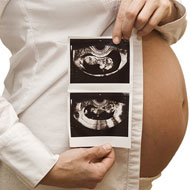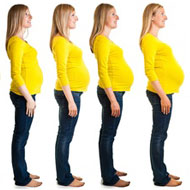Pregnancy Second Trimester: Body Changes, Symptoms & Fetus Development
The pregnancy second trimester marks an important phase for both mother and fetus. The mother usually finds this to be an easier stage as the morning sickness abates and she gets back her strength.
The umbilical cord, which supplied nutrition to the fetus, becomes thicker. During this time the fetus is vulnerable to the influences of harmful substances that may be ingested by the mother such as alcohol, drugs and medications.
Fetus Development During Second Trimester Pregnancy
In the womb, the fetus grows considerably as its weight increases and it develops into a fully formed baby.
When the second trimester ends the fetus will measure about thirteen inches long and will weigh about two pounds. During this time the fetus stars to kick and can turn on its sides. The eyes and ears slowly move into the correct positions. The fetus is also able to hear outside sounds such as the mother’s heartbeat. A whitish coating covers the body of the fetus. This is known as vernix caseosa and serves to protect the delicate skin of the fetus. Reflexes such as sucking and swallowing develop, and responses to certain stimuli are observed. The placenta fully develops and from the fifth month onwards, the important process of brain development takes place. Fingernails develop and the digits are fully formed. The fetus sleeps and wakes up in cycles. Woolly fine hair called lanugo covers the fetus’ body. Protective layers of fat form on the body. Fingerprints develop and the eyelids just begin to open.
Symptoms of Second trimester pregnancy
The mother especially enjoys the second trimester of pregnancy.
Nausea during pregnancy in the second trimester is more or less absent. Fatigue and soreness of the breasts subsides and she is able to fully experience the pregnancy without these discomforting symptoms. There are however other symptoms and changes that her body undergoes during this second phase of her pregnancy. Her appetite may increase and she may begin to experience the fetus’ movement for the first time. This occurs at week 20 and is known as quickening. The pregnancy becomes very visible now as the uterus grows and the abdomen swells considerably. As the skin of the abdomen stretches, it may start to itch and ache slightly. There may be a frequent urge to urinate as the uterus extends outside of the pelvis and eases the pressure on the uterus. Hormonal changes affect the nasal membranes, causing congestion. The texture of the gums may also change and bleeding may occur. Hemorrhoids and varicose veins are common during this time. A vaginal discharge that is white in color may be experienced. Discolored or bloody spotting in the second trimester of pregnancy may be a cause for concern and requires medical attention. The hormones released during pregnancy may cause skin pigmentation. Constipation, indigestion and heart burn may continue to occur in the second trimester as well.


